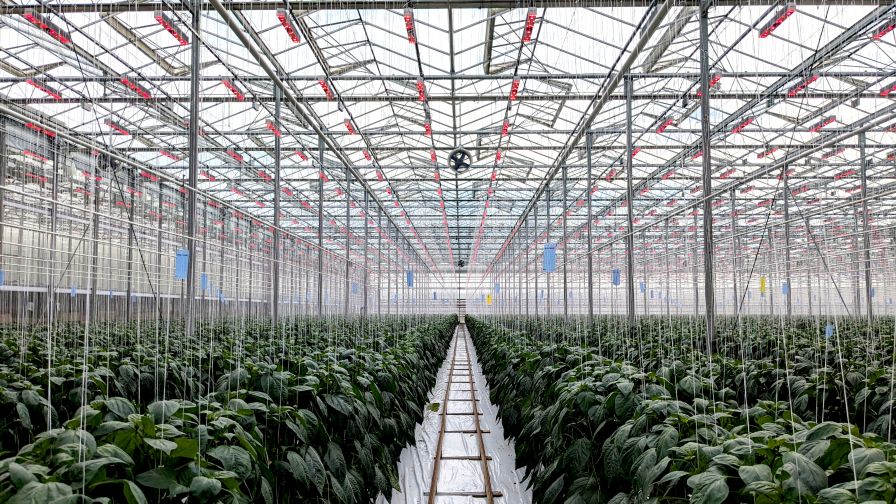
Light schedules and quality can be tailored for the time of day and stage of crop growth to maximize pepper production, as seen here with royal blue and deep red settings. Photo: Allegro Acres
To influence plant growth and vitality, growers can manipulate temperature, air speed, relative humidity, and CO2 concentration in their greenhouses. Dynamic lighting systems complement dynamic climate control systems by offering infinitely customizable light recipes for photoperiod, light intensity, and spectral quality. High-performance light-emitting diode (LED) lighting systems can be tools for growers to optimize production and yield their best and biggest harvests while reducing energy consumption and driving quicker cultivation cycles. Some utility programs offer additional rebates for dynamic lighting strategies.
What makes a horticultural lighting system dynamic? These systems are different than the color-tunable LED lights on the shelf at the hardware store, but their two primary characteristics are similar: dimming and tuning (color changing).
A light fixture is dynamic if it can provide one or both of the following:
- Multiple levels of light output (dimming)
- Multiple light recipes (spectral tuning)
Growers can get involved in the ways the industry is understanding the applications and benefits of dynamic lighting. Attend the Greenhouse Lighting and Systems Engineering (GLASE) Summit in Montréal on Nov. 6 to hear from North American growers, researchers, and manufacturers testing these systems in commercial greenhouses. Stay informed about how industry experts at the DesignLights Consortium Horticultural Lighting Controls Working Group are actively defining the performance requirements for dynamic lighting control systems.
Dynamic Dimming
Dimming controls adjust power output to achieve target light levels throughout a plant’s growth cycle. Dynamic light fixtures are typically operated with automated lighting control systems to schedule photoperiods and specify maximum light levels by time of day or phase of crop growth.
Daily light integral (DLI) controls are a sophisticated application of dimming that adjusts power to lighting systems to achieve a specified DLI given solar radiation sensed in the greenhouse each day. DLI controls give plants a more consistent environment by smoothing out spikes in light intensity caused by the sun and dips caused by cloudy skies. Using historical solar data and weather forecasts, DLI controls can predict the need for supplemental lighting and optimize light year-round.
Intelligent dimming controls save more energy than simply scheduling fixtures for a photoperiod set in stone, as the fixtures can continuously dim and turn off when light levels exceed targets. A study on DLI controls conducted in New York in 2020 concluded that DLI controls reduced electricity use from greenhouse lighting by 26% when compared to photo-
period and threshold lighting controls.
Dynamic Spectral Tuning
Spectral tuning is the modulation of output from the different diodes on LED fixtures so that the number of photons from each wavelength is tailored to influence plant quality attributes such as stem elongation, leaf size, flower development, fruit yield, and harvest cycle length. Spectral tuning is not limited to specific colors nor limited by a certain number of LED channels. Dynamic light fixtures can adjust spectral output with their control systems to provide unlimited combinations of wavelengths and achieve infinitely customizable light recipes. Growers can use spectral tuning to achieve the specific solar light spectrum and photoperiod from any location in the world at their farm. Tuning light recipes must be done with care; changing the red/blue ratio can trigger specific photomorphogenic responses, such as stem elongation and shade avoidance, which may be undesirable.
Growers across North America are exploring the benefits of dynamic lighting. In Ontario, Canada, greenhouse growers are tailoring lighting schedules and light quality for the time of day and stage of crop growth to maximize pepper production. In Ohio, producers of culinary herbs and specialty crops are retrofitting their greenhouses to comprehensively use dynamic LED systems to achieve consistent yields and faster harvests.
The Chef’s Garden in Huron, OH, is convinced of the benefits of dynamic lighting strategies. After installing 800 new dynamic LED fixtures manufactured by Sollum Technologies in 2022, the company installed 400 more in 2023. Its three-year plan is to light its greenhouses with 2,000 more fixtures. Before dynamic lighting, in December its micro
celery greens yielded 30% to 40% less than its May to September crops. After dynamic lighting, its harvest cycle was reduced from 53 to 38 days (a reduction of 30%) and yields are up.
“We can grow in the shortest days of the year within about 5% of what we can in the highest light time of the year. The yield has increased 30% to 35% because plants like that intensity and duration, and we love mimicking the sunrise, early day, mid-day, late day, and sunset. It’s a more natural approach,” says Bob Jones of The Chef’s Garden. “The energy benefits are fantastic, but they are secondary to yield and days to harvest.”
Getting Support for Dynamic Lighting Systems
Energy engineers can help growers get rebates and grants for dynamic lighting and control equipment. The Chef’s Garden has worked with Energy Resources Integration since 2023 to apply for utility rebates for the energy savings from its dynamic light fixtures and DLI controls strategies. In some cases, rebate programs have covered more than 60% of the equipment costs.
The USDA’s Rural Energy for America Program Energy Efficiency Improvement Guaranteed Loans & Grants program is another avenue for growers to get support for dynamic lighting construction projects. Greenhouses replacing lights can get grants for up to 50% of project costs (or a maximum award of $500,000) each year.
Take advantage of opportunities for funding dynamic lighting projects with experts; engineers at Energy Resources Integration can help identify solutions and find funding for any project type or size. Contact [email protected] to request a rebate and grant estimate.

